calsfoundation@cals.org
Arkansas Gazette
The Arkansas Gazette, Arkansas’s first newspaper, was established in 1819, seventeen years before Arkansas became a state. Its editorial stance for law and order during the desegregation of Central High School in 1957 earned the newspaper two Pulitzer Prizes—the first time in history one newspaper won two Pulitzers in the same year. Known for its liberal editorial pages in a conservative Southern state, the Gazette closed on October 18, 1991, after a bitter newspaper war with its cross-town rival, the Arkansas Democrat.
William E. Woodruff published the first edition of the Arkansas Gazette on November 20, 1819, introducing it as Republican (the name that evolved into the modern Democratic Party) in politics. Woodruff, a New Yorker who had completed a printer’s apprenticeship under Alden Spooner, arrived in Arkansas after working for newspapers in Louisville, Kentucky, and Nashville, Tennessee. The establishment of the Arkansas Territory in 1819 provided him an opportunity, so he bought a used Ramage press and brought it up the Arkansas River, arriving at Arkansas Post (Arkansas County) on Halloween. Early issues reported on the Arkansas Territory’s first election, Arkansas politics, and national news at the expense of local news. Woodruff, who befriended Chester Ashley, clashed with Robert Crittenden, secretary of the Arkansas Territory, because he refused to allow Crittenden to determine the editorial content of the newspaper. The Gazette got the appointment as public printer for the federal government, which allowed Woodruff to get his newspaper established despite delinquent subscribers, but Crittenden withheld printing jobs from Woodruff and tried to arrange for competition for his foe. After the territory’s seat of government was moved to Little Rock (Pulaski County), Woodruff eventually moved the Gazette headquarters there. He published the first issue in Little Rock on December 29, 1821.
Over the next several years, Woodruff’s Gazette played an important role in statewide elections and in helping the Arkansas Territory become a state. Over the next few decades, the newspaper was sold several times. Woodruff sold an interest in the newspaper to Thomas Jefferson Pew in 1836; Pew succeeded him as editor but returned his interest in the paper to Woodruff on May 16, 1838. A few months later, Woodruff sold the Gazette to his foreman, Edward Cole, who became editor on December 19, 1838. Cole, however, was unable to pay his debts, and George H. Burnett took over proprietorship in October 1840, again pledging to continue the paper’s support of the Democratic Party. Burnett, though, became seriously ill, and Stephen S. Tucker assumed control during his absence. Burnett died on December 17, 1841, and Woodruff resumed control of the paper again from 1841 to 1843. He sold it to Benjamin J. Borden, a lifelong Whig who changed the political affiliation of the paper during his ownership from 1843 to 1848. Woodruff began publication of the Arkansas Democrat in 1846 and transformed it into the Arkansas State Democrat on October 30, 1846, determined that it should be that party’s voice for the entire state. Borden’s sale of the Gazette to George B. Hayden, another Whig, was announced on February 10, 1848; the paper was sold to Dr. Albert H. Webb in January 1850, but he closed a deal a few weeks later to sell to Woodruff yet again, bringing the paper back to its Democratic leanings. On February 1, 1850, Woodruff announced he would merge his two papers as the Arkansas State Gazette and Democrat. He then sold the paper to Christopher Columbus Danley in March 1853. Danley vowed to keep the Gazette from being an organ of any political party, but as ownership began to think that the Democratic Party had abandoned long-held principles, chiefly the slavery issue, the Gazette became a supporter of the new American Party, popularly known as the Know-Nothing Party.
Danley and the paper survived an 1854 fire that destroyed the Gazette building, despite a nine-week suspension. On July 9, 1859, Danley’s paper became the Arkansas State Gazette following the demise of the Know-Nothings. After Abraham Lincoln was elected president as a Republican in 1860, Danley and the Gazette urged a calm, objective approach as many Southerners urged immediate secession.
Paper shortages during the war hurt the Gazette, as they did most other Southern newspapers. It suspended operation on September 10, 1863, when Union forces captured Little Rock. Danley and William Holtzman revived the Gazette on May 10, 1865. Danley editorialized in favor of resumed allegiance to the Union. The Gazette became the first state newspaper to subscribe to new telegraphic services that gave it access to news from places such as St. Louis, Missouri; Memphis, Tennessee; and New Orleans, Louisiana. Danley died on October 3, 1865, and Holtzman continued alone to make the paper, which had recently been called the Arkansas State Gazette and the Little Rock Daily Gazette, a non-partisan publication. In poor health, Holtzman sold to William E. Woodruff Jr., the son of its founder, in 1866. Woodruff added steam presses and changed the name back to the original Arkansas Gazette, which it would bear until its demise. After Reconstruction began in 1867, the Gazette became a leader in the Democratic opposition, advocating any means necessary to end Republican rule.
On July 1, 1902, John Netherland Heiskell, then twenty-nine, took the reins as editor-in-chief. His brother, Fred Heiskell, served as managing editor. The Heiskell brothers reinvigorated the Gazette at a time when it was considered to be second to the Arkansas Democrat under James Mitchell. Changes included removing ads from the front page, constructing a new three-story building at 3rd and Louisiana streets in Little Rock, and updating equipment. Over the years, the Heiskell brothers reinvested their profits in the newspaper, buying a new press and going to a seven-day-a-week publication schedule. In 1908, they added color comics.
At the end of the nineteenth century, the Gazette found an enemy in Governor Jeff Davis, who played the race card in Arkansas politics, speaking in favor of lynching and once promising to “fill the penitentiary so full of niggers their feet would be sticking out of the windows.” Both the Gazette and the Democrat criticized him, publicizing his scandals, which included accepting bribes, and Davis referred to the Gazette as “that old red harlot. I had rather be caught with a dead buzzard under my arm, or a dead polecat.” In an ironic twist, after Davis died in 1913, J. N. Heiskell was appointed to serve out the remainder of his term in the Senate.
Heiskell hired reporters with journalism degrees, including many from the University of Arkansas (UA) in Fayetteville (Washington County). Under his leadership, the Gazette earned its reputation as the newspaper of record for the state as well as a literary publication that was very protective of the English language. In the years leading up to the United States’ entry into World War II, the Gazette acquired a new press and an Associated Press wire photo machine.
After the death of his son during the war, Heiskell turned to the only other male in the family with relevant experience, naming son-in-law Hugh B. Patterson as publisher in 1948. Patterson, after consolidating ownership of the Gazette within the Heiskell family, led a modernization of the business office and equipment. Joining Heiskell and Patterson was Harry Ashmore, who came on as executive editor in 1947. Ashmore correctly anticipated that the coming of the race issue would be the major story of the mid-twentieth century, and his arrival in Little Rock marked a major development in American journalism and history.
After the 1954 Brown v. Board of Education of Topeka, Kansas ruling that mandated desegregation of American schools, the Little Rock School District put together a plan for gradual desegregation beginning in the fall of 1957. The Gazette editorialized that Little Rock could be a model for the rest of the country, but on the eve of the opening of the schools, Ashmore got word that Governor Orval Faubus planned to stop the integration. Ashmore met with Patterson and Heiskell at the Gazette building to plan the newspaper’s stance on the issue. Ashmore and Patterson believed that the Gazette’s editorial position should be for law and order, which at the time amounted to endorsing integration. Heiskell reportedly listened to the two, then turned his swivel chair to look out onto Louisiana Street and said, “I’m not going to let those people take over my town,” referring to the threats of mob violence in the streets. That settled the Gazette stance.
Faubus called out an armed detachment of the Arkansas National Guard to surround Central High School, ostensibly to quell mob violence. The guardsmen turned away the Little Rock Nine as they tried to enter the school. Ashmore and the Gazette answered vehemently with the front-page editorial, “The Crisis Mr. Faubus Made” on September 4, 1957, taking the argument beyond segregation versus integration to the supremacy of the federal government in all matters of law. As the days and weeks wore on, the Gazette covered all the developments of the ongoing crisis.
The Gazette’s stance for law and order cost the newspaper and the Heiskell family millions of dollars in advertising and circulation losses. Circulation dropped from 100,000 to 83,000 in a matter of weeks, and Ashmore and other Gazette employees, along with the perceived integrationists, were threatened with violence. However, in May 1958, the Gazette won the Pulitzer Prize for Public Service for its coverage of the Central High story. Ashmore won the Pulitzer for distinguished editorial writing. In October of that year, the Gazette also won the Freedom Award, presented yearly to individuals or groups who had significantly aided the cause of freedom.
In the aftermath of the Central High crisis, the Gazette reigned as one of the great newspapers of the country. Many of its reporters and editors moved on to other major publications such as the New York Times, Atlantic Monthly, the New Yorker, the New York Herald Tribune, the Philadelphia Inquirer and the Chicago Tribune. The Gazette was able to recruit new talent from a national pool and eventually regained its circulation lead over the Democrat. In 1972, Heiskell died after having led the Gazette for seventy years.
In 1974, the Arkansas-based WEHCO Media bought the struggling Arkansas Democrat. The Palmer family was an old name in Arkansas journalism, and after Walter E. Hussman Sr. married into the family, he helped consolidate a chain of monopoly papers in South Arkansas, a television station, and profitable cable television holdings into a family fortune.
Walter E. Hussman Jr., then twenty-seven years old, was named publisher and immediately began to try to make the Democrat competitive with the Gazette. Some of Hussman’s initial strategies worked for a time, but in 1977, he approached Patterson about a joint operating agreement that would keep the Gazette as the dominant paper with the Democrat remaining as the secondary afternoon paper, with some profits to be split. Patterson declined the offer twice. Hussman and his father were on the verge of closing the Democrat when they decided to make one final push. Hussman’s strategy included switching from afternoon to morning circulation, increasing the news hole, adding free classified ads, and selling retail advertising to cover newsprint and ink costs. His hiring of John Robert Starr as managing editor in 1978 marked the official beginning of the newspaper war. In 1984, the Democrat announced that it posted a profit for the year, but some said that announcement was a publicity stunt and that the profit was for only one month. Shortly afterward, the Patterson family filed an anti-trust lawsuit against Hussman’s Democrat for unfair business practices, particularly the free want ads and one-dollar-an-inch retail advertising rates. Part of the Democrat’s defense was its continuing losses and the Gazette’s ongoing profits, highlighted by a healthy bonus to Patterson. A jury ruled against the Gazette in March 1986, and the Patterson family began shopping for a buyer.
On October 31, 1986, the Gannett Corporation, owner of USA Today and several other newspapers, purchased the Gazette. Gannett brought in a steady stream of company executives who tried to revamp the Gazette with color photographs, jazzier stories, and more emphasis on soft news and features. Readers took umbrage at many of the changes, and Hussman and the Democrat used their advantage of being the locally owned product, although such innovations as color photography had been a staple of the Democrat for some time. Gannett had stockholders to answer to; Hussman answered only to his family.
Gannett also lost the Gazette’s biggest advertiser, Dillard’s, when Hussman proved to William Dillard that, under Gannett, smaller advertisers were given lower rates than those given to Dillard’s. Dillard was already angry with the Gazette over a prominent story about his grandson’s late-night spree of vandalism and a front-page story about a dispute between the company and its accounting firm and had pulled its advertising, and Gannett executives’ attempts to recover the account were thwarted with Hussman’s proof of lower rates.
The Gazette under Gannett also lost its public face. Orville Henry, the long-time sports editor whom many people credited with helping keep the Gazette afloat during the aftermath of the Central High crisis, had moved during the Patterson years to focus on his coverage of University of Arkansas Razorback athletics, giving up his administrative duties. Under Gannett and its stream of outside sports editors, Henry became increasingly unhappy. According to Gazette insiders, the Gannett leadership did not appreciate Henry and his style of long prose, and Henry approached Hussman through Little Rock businessman Jack Stephens about moving to the Democrat. The deal was quickly completed.
Despite the missteps, Gannett had increased staff with a string of bureaus around the state and had made advancements in the hiring of women and minorities. The Gazette won the Arkansas Press Association’s first-place general excellence award for large dailies in July 1991, as well as sixteen other first-place awards. The Democrat won three. Under Heiskell, the Gazette had not entered such contests because he thought it would have been unfair to smaller dailies. Gannett officials, though, ordered the staff to enter these contests in the 1980s. As Gannett continued its stream of top executives to the Gazette, many staff members and long-time readers became increasingly unhappy with the changes in the newspaper, although independent arbiters noted that the Gazette still had a higher circulation. Those numbers, though, were spiked by promotional efforts.
The first rumors of a possible sale to Hussman hit Little Rock’s KTHV Channel 11 around Labor Day 1991, but Gannett officials would not comment on the questions, and Hussman claimed that the rumors must have been coming from the Gazette’s circulation department. A committee made up of several Gazette employees and other supporters formed to try to put together an offer to buy the newspaper, and employees and supporters held rallies, but their efforts failed.
On October 18, 1991, word came down to employees in the Gazette building that the sale to Hussman would be announced that day and that that day’s edition would be the final one after almost 172 years. Although Hussman did not allow for a farewell edition, a farewell editorial ran, echoing Heiskell’s Freedom Award dinner speech from 1958, as did a front-page story on the failed employee buyout and a photograph of William Woodruff’s grave with supportive mementos left there during the rumors of the previous day. Late that afternoon came the announcement that the $68 million sale was complete. Guards watched as the unemployed Gazette staffers carried their belongings from the building. A candlelight vigil on 3rd Street in front of the Gazette building that night drew hundreds of people and commemorated the death of the oldest continuous newspaper west of the Mississippi River. On October 19, 1991, the first issue of the Arkansas Democrat-Gazette was published. In the end, Hussman likely spent $200 million in his conquest.
As the state’s newspaper of record, the Arkansas Gazette chronicled the history of Arkansas from 1819 onward. Traditionally, it held a liberal viewpoint in a largely conservative state, and in many ways, it changed the course of Arkansas history and politics as it editorialized in favor of moderate to liberal candidates such as Winthrop Rockefeller, Dale Bumpers, David Pryor, and Bill Clinton. In the final editorial on October 18, 1991, the Gazette’s Jerry Dhonau wrote, “We will take our leave mindful of the words of St. Paul, who wrote: ‘I have fought a good fight, I have finished my course, I have kept the faith.’ We believe the Arkansas Gazette has kept the faith and we are proud to have had the privilege for almost two centuries.”
For additional information:
Allsopp, Frederick W. History of the Arkansas Press for a Hundred Years and More. Little Rock: Parke-Harper Publishing Co., 1922.
Arkansas Gazette Business Files, 1819–1981. Center for Arkansas History and Culture. University of Arkansas at Little Rock, Little Rock, Arkansas.
Arkansas Gazette Project. David and Barbara Pryor Center for Arkansas Oral and Visual History. University of Arkansas Libraries, Fayetteville, Arkansas. Online at http://pryorcenter.uark.edu/project.php?projectFolder=Arkansas%20Gazette&thisProject=2&projectdisplayName=Arkansas%20Gazette%20Project (accessed July 30, 2021).
Clark, Kevin, director. The Old Gray Lady: Arkansas’s First Newspaper. DVD. Documentary film, 2006.
Dougan, Michael. Community Diaries: Arkansas Newspapering, 1819–2002. Little Rock: August House, 2003.
Massey, Kyle. “No Fiercer Newspaper War: 25 Years after the Arkansas Gazette’s Closing, Veterans Consider Consequences.” Arkansas Business, August29–September 4, 2016, pp. 1, 8–11.
Reed, Roy, ed. Looking Back at the Arkansas Gazette: An Oral History. Fayetteville: University of Arkansas Press, 2009.
Ross, Margaret. Arkansas Gazette: The Early Years, 1819–1866. Little Rock: Arkansas Gazette Foundation, 1969.
Stephens, Donna Lampkin. “The Conscience of the Arkansas Gazette.” Journalism History 38 (Spring 2012): 34–42.
———. If It Ain’t Broke, Break It: How Corporate Journalism Killed the Arkansas Gazette. Fayetteville: University of Arkansas Press, 2015.
Donna Lampkin Stephens
University of Central Arkansas
 Allbright, Charles Wilson
Allbright, Charles Wilson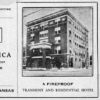 Allsopp, Fred
Allsopp, Fred Dearmore, Thomas Lee (Tom)
Dearmore, Thomas Lee (Tom)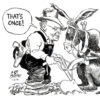 Duvall, Leland Blaine
Duvall, Leland Blaine Graham, William Karr (Bill)
Graham, William Karr (Bill) Mass Media
Mass Media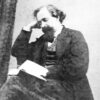 Newspapers during the Civil War
Newspapers during the Civil War Powell, James Ormond
Powell, James Ormond Reed, Roy
Reed, Roy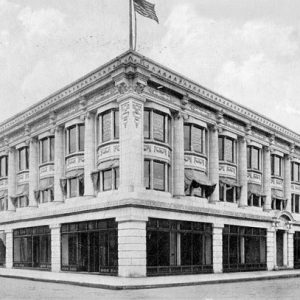 Arkansas Gazette Building
Arkansas Gazette Building  Arkansas Gazette Comp Room
Arkansas Gazette Comp Room 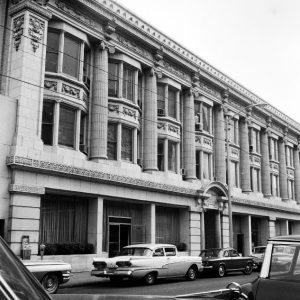 Arkansas Gazette Building
Arkansas Gazette Building  Arkansas Gazette Printing Plant
Arkansas Gazette Printing Plant 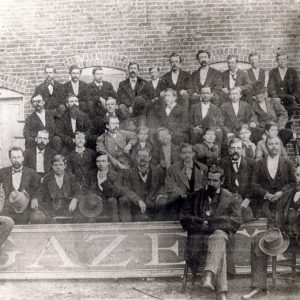 Arkansas Gazette Staff
Arkansas Gazette Staff  Arkansas Gazette Staff
Arkansas Gazette Staff 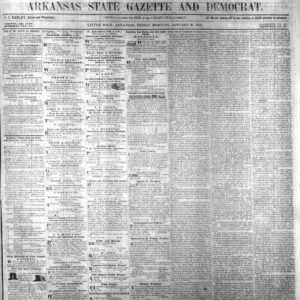 Arkansas State Gazette and Democrat
Arkansas State Gazette and Democrat  Harry Ashmore
Harry Ashmore 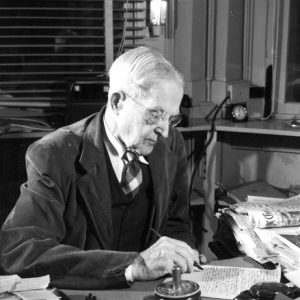 J. N. Heiskell
J. N. Heiskell 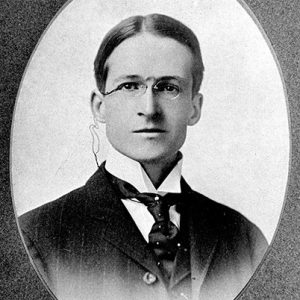 J. N. Heiskell
J. N. Heiskell  Roy Reed
Roy Reed 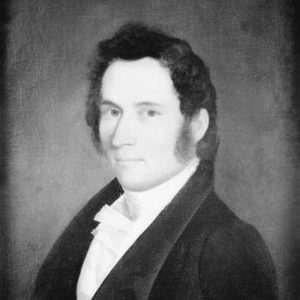 William Woodruff
William Woodruff 




I believe the Pulitzer Prize was removed from the Gazette building shortly before the paper closed. I’m wondering where it was taken.